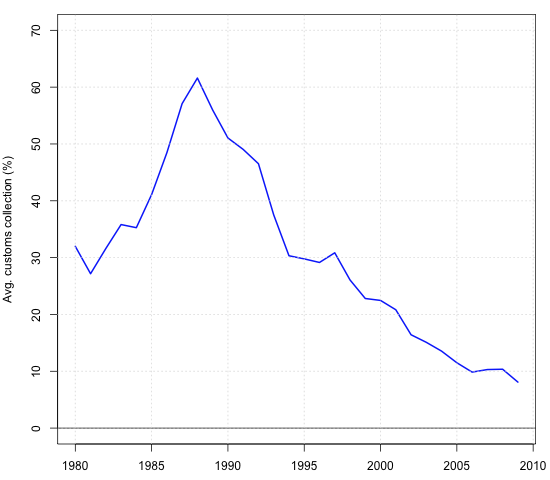Where did the Bombay Club go wrong?
Financial Express, 14 December 2009
The Bombay Club argument
In 1992, the `Bombay Club' led a lobbying effort by domestic industrialists against removing trade barriers. It was a seductive argument. They said they are in favour of removing barriers to imports, but they first required `fair' competition with imports on a `level playing field'. Indian companies must get access to reliable and trustworthy electricity, high quality ports and airports, a sensible framework of labour law and a sound GST, a good financial system, etc. Only when all these things are done would Indian companies have a level playing field when competing against imports made by foreign companies. Only when these preconditions are met, it be fair to remove trade barriers.
Trade liberalisation sans preconditions
 In the event, India made little progress on electricity or airports, got a bit better on ports, and did nothing to reform labour law. The stock market got better, but the remainder of Indian finance was unreformed. To most people, the Bombay Club argument seemed rather reasonable: how can the floodgates be thrown open to lean foreign competitors while Indian companies are hobbled thusly? But the ceaseless efforts of economists prevailed. Without waiting for these `preconditions for a level playing field', trade barriers were scaled down.
In the event, India made little progress on electricity or airports, got a bit better on ports, and did nothing to reform labour law. The stock market got better, but the remainder of Indian finance was unreformed. To most people, the Bombay Club argument seemed rather reasonable: how can the floodgates be thrown open to lean foreign competitors while Indian companies are hobbled thusly? But the ceaseless efforts of economists prevailed. Without waiting for these `preconditions for a level playing field', trade barriers were scaled down.
Customs collections as percent of merchandise imports dropped first from the worst value of 61.6% in 1987-88 to 37.5% in 1992-93, and stagnated to 30.85% in 1996-97 as lobbying by industry resurged. When a tariff goes from 100% to 30%, there is still a lot of fat for local producers; but progress from 30% to zero arouses greater opposition from local producers. In Yashwant Sinha's period, the tactic of cutting the "peak rate" by five percentage points every year broke through these political barriers. India's pernicious quantitative restrictions (QRs) were removed through the WTO process. The average customs collection then crashed to 8.09% in 2008-09. Nominal imports (in rupees) grew 60-fold in 21 years!
Why was there no calamity?
What happened to the domestic companies, the supposedly helpless ones who were hobbled with bad electricity, bad ports, bad airports, bad labour law, etc.? There was no calamity -- the Indian economy got dramatically better through globalisation. Even though the argument of the Bombay Club sounds reasonable, there is something fatally wrong with it. With the benefit of hindsight, we can identify five mistakes in the logic:
- There are many inputs to production and every location in the world has a different set of price advantages. While a location in India fares badly on some inputs (such as electricity or roads) it fares well in others (such as the price of labour). Overall competitive advantage reflects the cost of all inputs. In India, some inputs like electricity are costlier, but other inputs such as labour are cheaper.
- The exchange rate is a great equaliser. When a country removes trade barriers, imports get cheaper and the current account deficit tends to go up. But as long as the exchange rate is allowed to fluctuate, a currency depreciation results, which makes exports more competitive and imports costlier.
- When India opened up, many firms died. Their death freed up capital and labour which went into other firms, often in other industries. So while India's opening up was a calamity for many individual firms and also some industries (e.g. computer hardware), it worked well for India, by rearranging the utilisation of labour and capital.
- The Bombay Club, and old Indian economic policy makers, were pessimistic about what Indian firms are capable of. The events have belied this pessimism. When competitive pressure came upon Indian firms, they worked wonders on reshaping themselves, absorbing new technology, recruiting talent including foreigners, etc. The malleability of human behaviour exceeds the expectations of practical people.
- Once the pressure of imports came on, political lobbying by Indian companies started pushing politicians on reforms -- e.g. cutting restrictions on foreign inputs such as coal or debt capital, building highways, breaking the grip of DOT over telecom, etc.
The multi-headed hydra of protectionism
This story needs recounting today because protectionism, and the `level playing field' argument, is alive and well in India. Lawyers in India say that foreign legal firms can come into India - but only after some domestic preconditions are met. University heads in India say that foreign universities can come into India - but only after the policy framework for local universities is reformed. Bankers in India say that foreign banks can setup operations in India - but only after domestic banking reforms are done. The bogey of reciprocity is also brought up by incumbent producers trying to stave off competition.
The focus of policy makers should be to do good things for customers and not for producers. The customers of legal services in India will get a better deal if foreign legal firms come in. The students of India will get a better deal if foreign universities come in. The customers of banks in India will get a better deal if foreign banks come in. Once the forces of competition are unleashed, by removing barriers to globalisation, many other changes will come about (the five elements of adjustment described above). India will ultimately come out stronger.
See the companion piece: Trade liberalisation: Looking beyond the WTO.
Back up to Ajay Shah's 2009 media page
Back up to Ajay Shah's home page